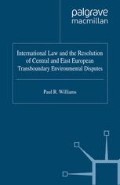Abstract
Given the relatively active role of international law and the legal process in the Gabčíkovo–Nagymaros Project dispute, and the significant reliance on international law by the participants in the Baltic Sea dispute, as well as its increasing use in the Black Sea and Danube River Gauntlet disputes, this chapter seeks to gauge whether there might be an increasing use of international law by CEE states to assist in the resolution of their transboundary environmental disputes. To accomplish this task, this chapter examines the status of the six factors, identified in Chapter 8, that promote the functionality of international law within the regime of transboundary environmental protection.
Access this chapter
Tax calculation will be finalised at checkout
Purchases are for personal use only
Preview
Unable to display preview. Download preview PDF.
Author information
Authors and Affiliations
Copyright information
© 2000 Paul R. Williams
About this chapter
Cite this chapter
Williams, P.R. (2000). Predicting the Future. In: International Law and the Resolution of Central and East European Transboundary Environmental Disputes. Palgrave Macmillan, London. https://doi.org/10.1057/9780333978078_11
Download citation
DOI: https://doi.org/10.1057/9780333978078_11
Publisher Name: Palgrave Macmillan, London
Print ISBN: 978-1-349-41483-3
Online ISBN: 978-0-333-97807-8
eBook Packages: Palgrave Social & Cultural Studies CollectionSocial Sciences (R0)

